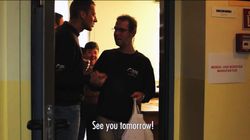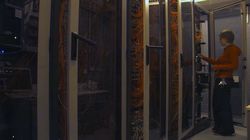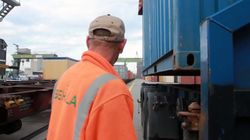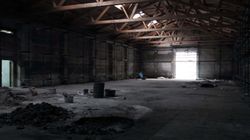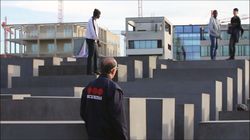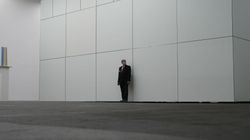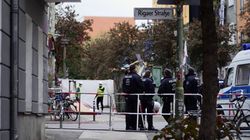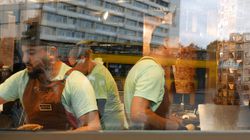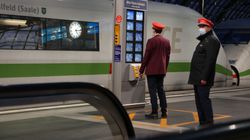Berlin|Germany
Statistical Data
Google entries for Berlin 970.000.000
Google entries per inhabitant 275,92
City Founding 1237
Surface area 891,82 km²
http://de.wikipedia.org/wiki/Einwohnerentwicklung_von_Berlin
CLIMATE DATA
Max. temperature Ø 13,1
Min. temperature Ø 5,7
Rainfall / year (mm) 570,8
Days of rain 109
http://de.wikipedia.org/wiki/Berlin
POPULATION
Inhabitants 3.515.473
Population density 3.942 inh. / km²
http://de.wikipedia.org/wiki/Einwohnerentwicklung_von_Berlin
Age groups in % (2010)
0–14 12
15-65 69
>65 19
http://www.berlin.de/imperia/md/content/seninn/zsb/gesundheitsmanagement/gesundheitsbericht_2010.pdf?start&ts=1329995943&file=gesundheitsbericht_2010.pdf
Population history
1825 220.277
1942 (peak level) 4.478.102
1945 2.807.405
1960 3.274.016
2000 3.382.169
2012 3.515.473
http://de.wikipedia.org/wiki/Einwohnerentwicklung_von_Berlin
2030 3.750.000
http://www.berliner-zeitung.de/berlin/steigende-einwohnerzahl-boomtown-berlin,10809148,20759430.html
RELIGIONS (in %)
Unaffiliated with any religion 60
Protestants 18,7
Catholics 9,2
Islamic migration background 5,7-8,6
Other Christian confessions 2,7
Jews 0,3
Others 0,6
http://de.wikipedia.org/wiki/Berlin
ECONOMIC OUTPUT
GDP (2010) 101,4 billion EUR [1]
GDP per Capita (2010) 27.499 EURO [2]
[1] http://www.berlin.de/imperia/md/content/sen-wirtschaft/konjunkturdaten/a_03.pdf?start&ts=1343310541&file=a_03.pdf
[2] http://www.ihk-berlin.de/linkableblob/2033704/.5./data/WIZ_Berliner_Wirtschaft_in_Zahlen_2011-data.pdf;jsessionid=15D488361E167192403CCB4095D9CA67.repl1
Average salary (gross) (2. quarter 2012) 2.966 EUR
Chief executives (14,7% of employees) 6.654 EUR
Skilled workers (43,6 % of employees) 2.846 EUR
Semi-skilled workers (11,3 % of employees) 2.163 EUR
Unskilled workers (3,8 % of employees) 1.832 EUR
http://www.statistik-berlin-brandenburg.de/pms/2012/12-10-25a.pdf
Employees with social security by economic sector (31.12.2011)
Total 1.177.948
Agriculture, farming, fishing 351
Manufacturing industry 128.625
Building sector 52.220
Commerce 144.627
Traffic and Logistic 60.461
Catering and hotel industry 54.255
Information and communication 60.805
Financial and insurance services 34.887
Real estate and Housing 24.478
Freelance scientific, technical and
economical services 213.025
Public and private services 403.925
http://www.statistik-berlin-brandenburg.de/Publikationen/Stat_Berichte/2012/SB_A06-15-00_2011q04_BE.pdf
Informal labor / "shadow economy"
3-15% of money in circulation
343 billion EUR (2012)
Why is there such disparity among estimates of the extent of undeclared work, varying between 3 and a substantial 15 percent of economic output? There is no doubt that due to its illegality, the extent of undeclared work can only be estimated, and not be measured directly. Empirically, researchers and practicians approximate the extent of undeclared work by measuring the amount of currency in circulation. Illegal work and the informal economy are largely carried out in cash. What differentiates individual calculations from one another are the assumptions about how rapidly money circulates: when one doubles the money's assumed velocity, the very same Euro bill can be used twice to fund illegal activities. Even new valuation models can not help but fall back up on these assumptions, because they merely provide an index which must then be converted into percentages of Gross Domestic Product, in which the results of cash circulation estimates are inevitably used. In fact, this is the crucial point, which is why researcher Ulrich Thießen of the German Institute for Economic Research (DIW) revalued sharply downward the estimated extent of the black-market economy: "The assumed high velocity of cash circulation in the shadow economy contradicts monetary trends, plausibility calculations and what we know from surveys."
http://www.iaw.edu/iaw/De:Aktuelles:Pressemitteilungen
Unions
191,637 unionized workers (31.12.2011)
DGB, Berlin
Strikes
12,500 BVG employees, February 17th 2012
B.Z. / Dpa / DAPD
TRAFFIC
Road network 5400 km [1]
Registered motor vehicles 1.327.015 million [2]
whereof cars 1.135.704 [2]
Cars per 1.000 inhabitants 328 [3]
Bicycles per 1.000 inhabitants 721 [3]
[1] http://www.stadtentwicklung.berlin.de/verkehr/politik_planung/zahlen_fakten/entwicklung/de/kfz.shtml
[2] http://www.auto-motor-und-sport.de/news/pkw-bestand-2011-wer-hat-die-meisten-auf-der-strasse-4331822.html
[3] http://www.berlin.de/imperia/md/content/rbm-skzl/120925_berlin_eine_erfolgsgeschichte_2012.pdf?start&ts=1348579199&file=120925_berlin_eine_erfolgsgeschichte_2012.pdf
Public traffic
Street network 5400 km
Daily users of the VBB
(Transport system Berlin-Brandenburg) 3,47 million
Bus network 1.095 km
S-Bahn network 257 km
Streetcar network 186 km
Metro network 145 km
http://www.berlin.de/imperia/md/content/rbm-skzl/120925_berlin_eine_erfolgsgeschichte_2012.pdf?start&ts=1348579199&file=120925_berlin_eine_erfolgsgeschichte_2012.pdf
LIVING COSTS
Number of working hours required for the purchase of…
1 Big Mac min. 16
1kg Bread min. 11
1kg Reis min. 9
1 iPhone 4S 16GB hrs. 55,5
http://www.ubs.com/global/en/wealth_management/wealth_management_research/prices_earnings.html
Prices (in EUR)
12 eggs 2,16,-
1 kg tomatoes 2,31,-
Bread for 2 people (1 Tag) 1,29,-
0,5 l beer in a super market 0,87,-
1 l milk 0,85,-
Cleaning woman (1 hour) 10,61,-
Monthly rent for a 85 qm flat in
an expensive neighbourhood 1.040,-
1 l petrol 1,59,-
Monthly ticket for public transport 74,0,-
Cab drive (8 Km) 18,68,-
http://www.expatistan.com
CITY OF TENANTS
Number of rental apartments 1.688.000 [1]
Number of owner-occupied flats 200.000 [1]
Additionally needed apartments by 2030 150.000 [2]
[1] http://www.rdm-berlin-brandenburg.de/aktuelles/mitteilungen/details/archive/2012/november/article/berlin-wenig-leerstand-viel-andrang.html?tx_ttnews[day]=22&cHash=e2f74a0213
[2] http://www.berliner-zeitung.de/berlin/steigende-einwohnerzahl-boomtown-berlin,10809148,20759430.html
Percentage of household income for the gross rental without heating in selected Berlin districts
Neukölln 30,7%
Friedrichshain-
Kreuzberg 29,4%
Mitte 28,4%
Lichtenberg 26,7%
Mahrzahn-
Hellerdsorf 28,1%
http://www.berliner-zeitung.de/berlin/mieten-in-berlin-singles-sind-am-staerksten-belastet,10809148,20910476.html
Changes in new rental contracts in selected
Berlin neighbourhoods (2007-2011)
Neukölln plus 21% - 30%
Friedrichshain-
Kreuzberg plus 31% - 40%
Mitte plus 21% - 30%
Lichtenberg plus 11% - 20%
Mahrzahn-
Hellersdorf plus 0% - 10%
http://www.neues-deutschland.de/artikel/805053.bis-zu-40-prozent-auf-die-neue-miete.html
POVERTY
Public and private debts
Berlin household 2012 22,276 billion [1]
Debts (30.06.2012) 60,894 billion [2]
Interest payments for old loans / year 2,3 billion [3]
Number of indebted individuals
in Berlin 371.165 [4]
Middle high debts 33.000 EUR [4]
Debtors in Tiergarten 16,95% of people over 18 years [4]
Debtors in Wedding 18,36% of people over 18 years [4]
[1] http://de.wikipedia.org/wiki/Berlin
[2] http://www.berlin.de/sen/finanzen/haushalt/basis/index.html
[3] http://www.in-berlin-brandenburg.com/Blog/2012/06/14/haushaltsplan-dem-abgeordnetenhaus
[4] http://www.creditreform.de/website/Berlin/Advanced/Downloads/Eigene_Downloads/Regionale_Analysen/2012-11_Analyse_Berlin_SchuldnerAtlas_2012.pdf
Poverty in Berlin (2011)
Poverty line 848,- EUR / Singles [1]
People below the poverty line 21,1% [1]
National average 15,1% [1]
Receivers of Hartz IV 580.723 [2]
Household communities
receiving Hartz IV 320.000 [2]
Poverty quota / under 3 years old 34,3% [3]
[1] http://www.tagesspiegel.de/berlin/studie-hohes-armutsrisiko-in-berlin/7390326.html
[2] http://www.morgenpost.de/berlin-aktuell/article106241817/Fuer-viele-Berliner-ist-das-Jobcenter-ein-ewiges-Sozialamt.html
[3] http://www.morgenpost.de/berlin-aktuell/article110073832/Jedes-dritte-Kleinkind-in-Berlin-lebt-in-Armut.html
Minimum wage despite full-time employment in Berlin
Minimum wage (East) 1.379 EUR / month
National average minimum wage 1.802 EUR / month
Full-time employees under the minimum
wage (East) 15,9 %
Fulltime-employees, national average
below the minimum wage limit 28,2 %
http://www.dgb.de/themen/++co++ac4f0354-fcb8-11e1-904f-00188b4dc422
Job cuts in the public service
Full-time jobs 1990 207.151 [1]
Full-time jobs 2011 101.501 [2]
[1] http://www.berliner-zeitung.de/archiv/seit-der-wende-wird-im-oeffentlichen-dienst-gespart---bei-angestellten-soll-weiter-gekuerzt-werden-97-000-stellen-sind-weg,10810590,10470620.html
[2] http://www.statistik-berlin-brandenburg.de/Publikationen/Stat_Berichte/2012/SB_L03-02-00_2011j01_BE.pdf
DEINDUSTRIALISATION
Employment in Germany (current state territory) in %
Manufacturing Industry 1939 8,7 1961 4,7 1989 3,8 2010 2,1
Trade and Traffic 1939 10,6 1961 5,5 1989 5,3 2010 3,9
Services 1939 15,9 1961 8,3 1989 5,0 2010 4,9
State and organisations 1939 16,5 1961 7,7 1989 7,1 2010 5,4
Total 1939 10,3 1961 5,6 1989 5,0 2010 4,0
http://www.statistik-berlin-brandenburg.de/produkte/zeitschrift/2012/HZ_201204.pdf
In 1989, approximately 400,000 workers were employed in industrial firms. In 2001 there were 175,000.
Berlins Industrie nach der Wiedervereinigung, hg. Fischer, Pohl, Semlinger, FHTW Berlin, https://www.berlin.de/imperia/md/content/senatsverwaltungen/senwaf/wirtschaft/semlinger.pdf?start&ts=1139403720&file=semlinger.pdf
Industrial workplaces
1971 427.500 [1]
1988 360.000 [2]
2011 105.000 [3]
[1] Berlin Handbuch; FAB Verlag, Berlin; 1993; S. 1395 ff
[2] http://www.buergerimstaat.de/2_97/bis972c.htm
[3] http://www.berlin.de/imperia/md/content/sen-wirtschaft/industrie/factsheet_industrie.pdf?start&ts=1348835370&file=factsheet_industrie.pdf
Disassembly Number
of dismantled factories in the Soviet-
occupied zone before August 2, 1945 988
August 3, 1945 to October 1, 1947 2.264
Total 3.152
http://www.opus.ub.uni-erlangen.de/opus/volltexte/2006/414/pdf/Diss.Ute%20Boehme.pdf
Loss ratio due to factory disassembly
by the Soviets after the end of the war
West sectors 67% [1]
East sectors 33% [1]
Capacity loss in the electrotechnical
industry in West Berlin 70-80% [2]
[1] Berlin Handbook; FAB Verlag, Berlin; 1993; S. 1395 ff
[2] http://www.opus.ub.uni-erlangen.de/opus/volltexte/2006/414/pdf/Diss.Ute%20Boehme.pdf
Degree of disassembly in various Siemens factories
Department Elmo 91%
Department for dynamos 90%
Department for conversion of current 89%
Cable department 74%
Switching network department 72%
Department for small parts 65%
Metal and iron foundry department 57%
Average disassemgly level 77%
http://www.opus.ub.uni-erlangen.de/opus/volltexte/2006/414/pdf/Diss.Ute%20Boehme.pdf
Number of machines in the 12 biggest engineering companies
1939 25.000
1945 88
Peter Schulz: A Viability Concept: Isolated West-Berlin as a Case Study, University of Illinois at Urbana-Champaign, 1971
Headquarters relocations
Migration of corporations
1944 3
1946 18
1947 37
1948-1949 64
Grischa Meyer, Rosinen aus Berlin; Lettre International, Nr. 96, Frühjahr 2012
Number of headquarters relocations after the blockade,
before 1950 320 [1]
AG + GmbH 1950 100 1951 60 1952 53
Others 1950 104 1951 76 1952 58
Total 1950 204 1951 136 1952 113 [2]
[1] http://www.berlin.de/imperia/md/content/wirtschaft_neu/masterplan_industrie.pdf?start&ts=1289568553&file=masterplan_industrie.pdf
[2] Alfred Zimm: Westberlin: der Industriestandort Westberlin unter den Bedingungen der Frontstadt; Deutscher Verlag der Wissenschaften; Berlin (1961)
Immigrant companies in the FRG 1953
Immigrant companies = companies whose proprietors migrated from the Russian Zone or of which such immigrants hold more than a 50% share.
Companies that moved to Berlin 3.436
Employees 190000
of which
Engineering industry 32000 Employees
Electro-technical industry 33000 Employees
Motor vehicle industry 10000 Employees
Textile industry 27000 Employees
Prof. Dr. Nikolaus Wolf, Standortfolgen der Deutschen Teilung, Power Point Präsentation, Freie Universität Berlin, Sommer 2006

